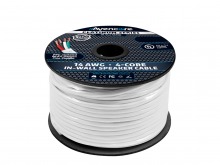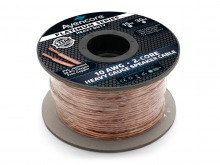
We get asked about speaker cable a lot, and with all the options, technical jargon and marketing snake-oil on the internet, it's easy to see why. But picking the right cable gauge which balances performance with budget isn't really that difficult. That's why we've distilled the advice we give to our over-the-counter customers into this handy guide. Now anybody can use one of our methods to select the right gauge of cable that will ensure safe operation of AV equipment at its best possible fidelity without over-spending.
All of our speaker cable is high-grade and suitable for permanent in-wall installation.
Before you even start thinking about speaker cable, you're probably going to start shopping around for your home entertainment system. Your budget here can be an easy indication of the type of money you should spend on the cable to go with it. If you're after a smaller soundbar or 5.1 system which sounds great but won't send bass shuddering through the walls, then your speaker budget may be as little as a few hundred dollars, and in turn will run at its very best on our thinnest cable - 16 AWG. Conversely if you've got your heart set on a much livelier system with more channels and a powerful subwoofer, you can easily put down thousands of dollars. For these bigger, beefier systems which typically go in larger rooms, we recommend you reach for heavier gauges like 12AWG.
Here are some example systems, separated by price range, with an AWG suggestion for each.
This table assumes average room sizes, listening volume and system power, but it's a good starting point if you don't know the technical specifications of your system or you're wiring a house 'blind'. Look below for a table which shows the cable length recommendations for each gauge.
In a perfect world, you could look up accurate wattage and impedance numbers for any amplifier, speaker pack or full home theatre system and be assured of your cabling needs. While this is possible with some brands, a large number of them (even some of the big ones) inflate or hide specifications to make their offerings look more capable while being harder to compare. More than this, amplifiers themselves usually only carry numbers for tone tests on one or two channels - not very helpful if you're running 5.1 or more and listening to actual audio! To simplify the electrical side of things, and taking into account the average power of even the most expensive home theatre audio packages available as of March 2018, we're going to use the impedance (Ohms) of the systems to recommend a gauge of speaker cable.
8 Ohm systems were common up to a few years ago, and offered flexible consumer-level home theatre systems with plenty of power for your living room. While new systems rarely run 8 Ohm hardware, the numbers are still relevant if you're moving house and keeping an old system, or inheriting one second hand. The most common impedance now that dedicated home theatres have become popular is 6 Ohm, and it covers the gamut between small stereo systems and huge Dolby Atmos/DTS:X packages. At the highest end (less common in the home theatre market) are the powerful 4 Ohm systems. These are audiophile territory and usually come at a hefty cost - not just to buy them but to run them, too. For each of these common impedance ratings, we've listed their recommended cable gauges.
Room size is also an important factor when planning your home theatre, as extended cable runs can introduce resistance which results in overheating. While it is possible to get away with thinner cable when your cable runs are very short, thicker cable is essential for long runs. In the traditional home theatre setup, the most powerful speakers are the front stereo channels which are situated just a few metres away from a centrally placed amplifier. If this is true for your configuration, then the table above is all you need to consult for a suitable cable gauge. If you have another configuration, such as your AV equipment at the back of the room, in a cabinet, or another area of the house entirely, cables to these high powered speakers may need to be bulked up.
Choosing a thicker cable is also worthy of consideration if you think you may upgrade your home theatre hardware to something more powerful in the future. Changing from an 8Ω system up to a 6Ω system (ostensibly so it can run at higher volumes) could put strain on a lower gauge cable and lead to audio problems or heat build up.
That's it! Many of our customers would be comfortable to stop reading here, choose a gauge from the tables above and be very happy with their purchase. But there are some other common questions and topics related to speaker cable that are worth including in this guide for completeness which may be helpful, too...

We love our 14AWG because it makes recommending speaker cable a no-brainer. Its core is only 0.3mm thicker in diameter than 16AWG - keeping it super-easy to work with - but it's 30% more efficient than 16AWG in terms of resistance. What's more, its jacket is UL CM/CL2 certified for additional peace of mind. This independent certification assures us that the PVC jacket is flame retardant and suitable for all uses up to 150 volts - way more than your speaker system can output.
While our other gauges of cable are clad in the same flame-retardant grade of PVC, and UL certification is not a legal requirement in Australia, it's a nice-to-have feature that makes 14AWG more attractive. What's more, our 14AWG comes in a 4-Core option designed to make installation of rear channels easier by carrying enough wires for two speakers in one jacket.
For audiophiles who need more than 14AWG for their massive systems, 4-core 14AWG can be bi-wired (combined) to create an effective 2-core 11AWG cable!
Bare wire connections to speaker terminals are simple, but some gauges of cable can be too thick - especially for spring clips. Optional plug connectors are sometimes sold as being better than direct wire connections, but don't be fooled. While each plug type has its own benefits, none of them will improve the audio quality of your system.
 Spring Clips can accept bare wire up to 14AWG without needing plugs
Spring Clips can accept bare wire up to 14AWG without needing plugs Pin Plugs allow up to 10AWG cable to be used with Spring Clip terminals
Pin Plugs allow up to 10AWG cable to be used with Spring Clip terminalsSee our range of Speaker Plugs
 Binding Posts can work directly with speaker cable up to 10AWG
Binding Posts can work directly with speaker cable up to 10AWG Banana Plugs allow for piggy-backing multiple speakers to a single terminal
Banana Plugs allow for piggy-backing multiple speakers to a single terminal Spade Plugs clean up frayed copper for easy, frequent plugging and unplugging
Spade Plugs clean up frayed copper for easy, frequent plugging and unpluggingSee our range of Speaker Plugs

10AWG is hefty cable. It's hard to work with, and it's overkill for most home theatre systems unless you're running very long distances (ie you have multi-zone audio to an outdoor area, or have a large venue you need to fill with sound). However, 10AWG is incredibly transparent and is a good idea for anybody with perfect hearing who wants the best possible audio performance out of their (very) high-end system. Generally you don't need 10AWG cable unless you already know you need 10AWG, and are prepared for the challenges it presents.
While it is definitely true that lower powered speakers (like rear channels) and smaller systems can be run on lighter cable like 18AWG or even 24AWG, our range of speaker cable starts at 16AWG. We've chosen this as our entry-level because it balances wide suitability with effective cost. Thinner cables aren't that much cheaper for us to source, and with the march of home theatre system sophistication over the last decade, 16AWG is a safer bet for today and for tomorrow.
Contact us with any questions you have about Speaker Cable and we'll do our best solve them!